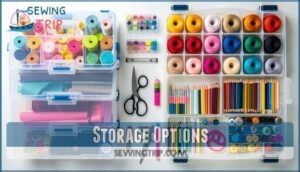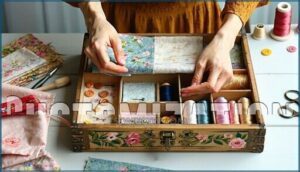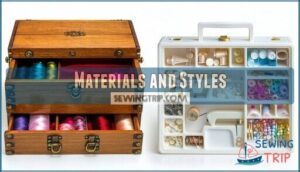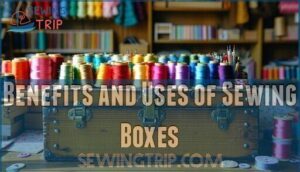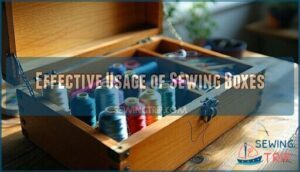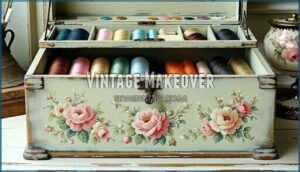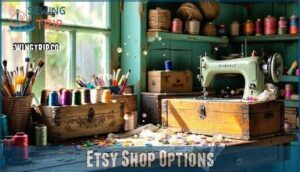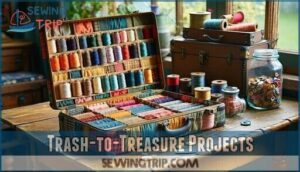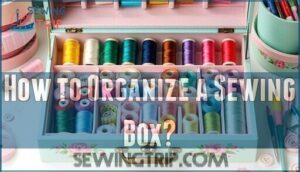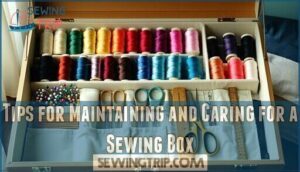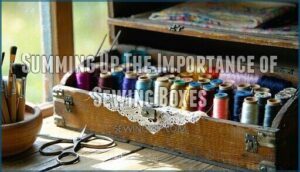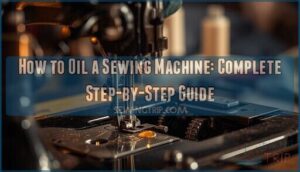This site is supported by our readers. We may earn a commission, at no cost to you, if you purchase through links.
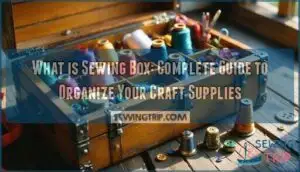
Think of it as a toolbox, but for needles, threads, scissors, pins, and more.
They come in all shapes and sizes—wooden boxes, plastic cases, or even stylish fabric totes—each designed to suit your crafting needs.
Some have compartments or trays for easy sorting, while others offer portability for sewing on the go.
Whether you’re mending clothes or tackling a quilting project, a sewing box guarantees everything stays in its place.
Ready to upgrade your crafting game? Let’s explore the best options!
Table Of Contents
- Key Takeaways
- What is a Sewing Box?
- Features and Types of Sewing Boxes
- Benefits and Uses of Sewing Boxes
- Effective Usage of Sewing Boxes
- Examples of Sewing Boxes
- How to Use a Sewing Box?
- How to Organize a Sewing Box?
- Tips for Maintaining and Caring for a Sewing Box
- Summing Up The Importance of Sewing Boxes
- Frequently Asked Questions (FAQs)
- Conclusion
Key Takeaways
- You’ll keep all your sewing essentials—needles, threads, scissors, and pins—organized and accessible in one dedicated container that transforms chaotic craft sessions into efficient workspaces.
- You can choose from various styles including wooden boxes, plastic cases, or fabric totes with compartments, trays, and dividers that suit your specific crafting needs and personal preferences.
- You’ll maximize your sewing box’s potential by organizing tools according to frequency of use, keeping everyday items in top compartments, and using small containers for buttons and notions.
- You can maintain your sewing box’s longevity through regular cleaning, proper tool inspection, and climate control while storing it in dry locations to prevent rust and preserve your valuable supplies.
What is a Sewing Box?
A sewing box is your personal command center for all things stitching—a specialized container that keeps your creative arsenal organized and ready for action.
Your sewing box: where chaos meets creativity and every thread finds its perfect home.
Unlike a basic sewing kit with just the bare essentials, a sewing box offers dedicated storage for your complete collection of sewing supplies and sewing notions.
These clever organizers have quite the historical context, dating back to the 1770s when wooden versions became fashionable accessories.
Through box evolution, they’ve transformed from simple storage into symbols of cultural significance among craftspeople.
Today’s sewing organizer comes packed with compartments, drawers, and clever dividers that give every thread, button, and needle its own special place.
The beauty lies in how box materials—from vintage wood to modern plastics—create functional art pieces.
Whether you’re mending a torn shirt or crafting a masterpiece, your sewing box becomes your trusted sidekick, keeping sewing essentials within arm’s reach while you work your magic.
Features and Types of Sewing Boxes
When you’re choosing a sewing box, you’ll find they come with various features like lift-out trays, fold-out compartments, and built-in pincushions that make organizing your supplies simple and efficient.
These boxes range from basic wooden designs to modern plastic models with adjustable dividers, giving you options that match both your storage needs and personal style.
They provide a way to keep your sewing supplies organized, which can be very efficient and make your work easier with adjustable dividers.
Design and Construction
Quality sewing box design focuses on structural integrity and user experience.
Construction materials range from traditional wood to modern plastics, each offering unique benefits.
Compartment types include removable trays, fixed dividers, and sliding sections that maximize organization.
Ergonomic design guarantees comfortable handling during extended crafting sessions.
Closure mechanisms vary from simple latches to magnetic seals, providing secure storage.
Material choices affect durability, while thoughtful sewing box features enhance functionality for every crafter’s needs.
Storage Options
Modern sewing boxes offer compartment variety through removable trays, adjustable dividers, and specialized slots for different tools.
Portable solutions include lightweight carriers with secure latches, while space optimization features stackable designs and vertical storage racks.
Material choice ranges from clear plastic for visibility to padded fabric protection, allowing you to maximize space by considering DIY storage solutions.
Security features like lockable compartments safeguard valuable accessories in your sewing storage system.
Customization
Customization transforms your sewing box from a basic container into a reflection of your creative personality.
You can create Personalized Dividers using cardboard or fabric to fit your specific tools perfectly.
Artistic Embellishments like painted designs, decorative paper, or fabric coverings make your box uniquely yours.
Custom Inserts help organize buttons, needles, and thread spools efficiently.
Fabric Choices for lining add both protection and personal style.
Unique Closures, such as vintage latches or ribbon ties, complete your sewing box personalization project beautifully, reflecting your unique touches.
Portability
When you’re constantly on the move, a portable sewing kit becomes your crafting companion.
Compact designs featuring lightweight materials make mobile crafting effortless, whether you’re traveling or need quick on-the-go repairs.
Travel sewing boxes with sturdy handles and secure latches guarantee your mini sewing kit stays organized during transport, bringing creative freedom wherever life takes you, and ensuring that you have a reliable crafting companion.
Materials and Styles
Beyond portability, the materials and style of your sewing box define both its character and longevity.
Wood varieties like oak and cherry offer timeless durability, while plastic molds provide lightweight convenience. Fabric linings protect delicate notions, and metal accents add sophisticated touches to any design.
Issey Miyake also explored the relationship between clothing and form by making clothing from a piece of cloth.
- Traditional wooden sewing box designs showcase craftsmanship through various wood varieties and aesthetic eras.
- Modern plastic sewing box options feature innovative plastic molds with customizable compartments.
- Hybrid sewing box types combine multiple sewing box materials for enhanced functionality and style appeal.
Benefits and Uses of Sewing Boxes
You’ll find that sewing boxes transform chaotic craft supplies into organized, accessible storage systems that make every project more efficient.
Whether you’re traveling to a quilting retreat, handling emergency repairs, or simply keeping your workspace tidy, these versatile containers adapt to your specific crafting needs while protecting your valuable tools and materials, making them an essential part of any crafting setup, and ultimately contributing to a more efficient and accessible crafting experience.
Travel Organization
With your portable sewing companion by your side, you’ll discover that creativity doesn’t have to stay home.
A well-organized travel sewing kit transforms any location into your personal crafting space, whether you’re waiting at the airport or relaxing at a vacation rental.
| Smart Packing Benefits | Creative Freedom Results |
|---|---|
| Compact Storage solutions keep your needles, threads, and scissors secure in designated compartments | On-the-Go Repairs become effortless when everything has its proper place |
Your sewing box portability guarantees that Travel Essentials like buttons, safety pins, and small scissors won’t scatter throughout your luggage.
Quality sewing box compartments protect delicate items from damage during transit, while a good sewing box organizer prevents thread tangles and lost needles.
Portable Kits designed for travel typically include fabric protection features like secure closures and padded sections.
You’ll appreciate having your sewing organization system ready when inspiration strikes or when emergency repairs are needed.
Smart travelers know that proper sewing box compartments make the difference between frustrating searches and efficient crafting sessions.
Storage and Organization
A well-organized sewing box transforms your crafting experience by providing dedicated spaces for every tool and supply.
Strategic storage solutions help you locate items quickly while protecting delicate materials from damage. A simple trick is to tape items inside the lid for easy access.
- Notion Compartments separate small items like buttons, pins, and needles
- Portable Solutions keep frequently used tools within easy reach
- Space Optimization maximizes storage capacity through smart compartment design
- Rust Prevention protects metal tools with proper ventilation and dry storage
- Box Longevity guarantees your sewing box organizer serves you for years
Crafting and Repairs
Your sewing box transforms into a creative powerhouse for both ambitious projects and quick repairs.
Your sewing box becomes your trusted creative sidekick, turning crafting chaos into organized magic.
Essential sewing supplies like needles, thread, and scissors handle mending techniques while supporting fabric selection for new ventures.
Pattern alterations become manageable with organized sewing notions at your fingertips, and creative embellishments add personal flair to projects.
Your trusty sewing kit guarantees you’re prepared for unexpected repairs and spontaneous crafting sessions, making it a vital part of your sewing kit.
Quilters’ Choice
Quilters face unique storage challenges with their specialized tools and extensive fabric collections.
Your sewing box becomes a command center for rotary cutters, quilting rulers, and precise fabric selection.
Smart thread organization prevents tangling while dedicated batting storage protects delicate materials from dust and moisture.
Sewing box quilters know that proper sewing box organization transforms chaotic craft rooms into efficient workspaces.
When sewing box tools and sewing box fabrics have designated homes, your quilting projects flow seamlessly from start to finish, with efficient workspaces.
Effective Usage of Sewing Boxes
You’ll maximize your sewing box’s potential by organizing tools according to frequency of use, keeping everyday items like scissors and thread spools in easily accessible top compartments.
Smart storage strategies, such as using small containers for buttons and dedicating specific sections for different craft projects, transform your sewing box from a jumbled mess into an efficient workspace that saves time and reduces frustration, by implementing smart storage strategies and creating an efficient workspace.
Inventory Management
Keeping track of your sewing supplies transforms chaos into crafting bliss. Smart sewing box inventory management saves time and prevents project delays when you can’t find that perfect button or matching thread.
- Tool Categorization: Group similar items together—needles with needles, threads by color families, and notions in designated compartments for quick access.
- Supply Tracking: Create a simple checklist of essential items, noting quantities and marking when supplies run low to avoid mid-project shopping trips.
- Stock Rotation: Place newer supplies behind older ones, ensuring you use materials before they deteriorate or tangle.
- Space Optimization: Maximize your sewing box storage by using small containers and dividers for efficient organization.
Dedicated Storage
Through careful tool segregation and space optimization, your sewing box becomes a masterpiece of layout efficiency.
Assign specific compartments for threads, needles, and bobbins to maintain accessibility design while ensuring item preservation.
This dedicated approach to sewing storage transforms chaos into order.
Your sewing accessories deserve their own homes within the organized system.
Smart sewing box organization tips include using small containers for buttons and separating sharp tools from delicate fabrics, creating a functional workspace that supports your creative projects, and ultimately leading to a well-designed sewing area that enhances your overall sewing experience with accessibility design.
Craft Caddy
Beyond dedicated storage, you’ll find that a craft caddy transforms your sewing box into a mobile command center.
This portable companion keeps your most-used sewing supplies and sewing accessories within arm’s reach while you work. Think of it as your personal assistant that never takes a coffee break.
Your craft caddy becomes the perfect solution for tool accessibility and space optimization. Unlike bulky sewing storage solutions, these compact organizers move with you from project to project.
Consider these practical approaches:
- Caddy Customization: Add foam inserts or small containers to create custom compartments for different sewing box organization tips
- Portable Projects: Choose lightweight materials that won’t strain your wrist during transport
- Caddy Alternatives: Repurpose tackle boxes or toolboxes for budget-friendly options
This approach puts everything you need right where you need it, making every crafting session more efficient and enjoyable. They’re also essential for organized travel with your sewing projects.
Organizing Strategies
Organizing your sewing box effectively transforms chaos into creative harmony.
Smart compartment segregation keeps your supplies accessible while maximizing every inch of available space.
Space optimization becomes effortless when you implement strategic tool accessibility methods.
| Organization Method | Best For | Benefits |
|---|---|---|
| Adjustable partitions | Mixed supplies | Flexible sizing |
| Portable caddies | Travel projects | Easy transport |
| Drawer systems | Heavy items | Stable storage |
Your sewing box interior layout should prioritize frequently used items in top compartments.
Clutter reduction happens naturally when you designate specific homes for threads, needles, and notions.
Consider using small containers within sewing box drawers to prevent items from shifting during transport.
This systematic approach guarantees you’ll spend more time creating and less time searching for misplaced supplies.
Examples of Sewing Boxes
You’ll find sewing boxes come in many different styles, from classic wooden designs with multiple compartments to creative upcycled containers made from tackle boxes or vintage suitcases.
These examples show how you can choose between traditional options like elegant antique boxes or modern solutions that transform everyday items into organized craft storage.
Wooden Sewing Boxes
Wooden sewing boxes showcase timeless craftsmanship through various wood types like oak, mahogany, and pine.
These antique sewing boxes often feature intricate joinery techniques and custom engraving that reflect their era’s artistry.
You can restore vintage sewing box pieces using antique restoration methods, or try DIY building projects.
Many wooden sewing box designs include multiple drawers for ideal organization, and you can find various styles and sizes online, which also highlights the custom engraving and antique restoration methods.
Vintage Makeover
Transform thrift store finds into stunning vintage sewing box masterpieces with simple DIY techniques.
Start your sewing box restoration by cleaning the surface thoroughly, then apply primer for proper surface preparation. Paint with chalk or milk paint for that authentic aged look.
Add artistic embellishments like vintage transfers, decorative handles, or distressed edges to enhance the charm. Sand lightly between coats for smooth finishes.
Many enthusiasts also seek specialized vintage attachments to enhance their sewing machines.
Your antique sewing boxes deserve this loving sewing box refurbishment, creating chic sewing boxes that blend functionality with timeless vintage appeal perfectly.
Etsy Shop Options
Etsy marketplace offers countless vintage sewing box and wooden sewing box treasures from creative sellers worldwide.
You’ll discover handcrafted storage solutions that transform your craft space into something special.
Many customers find Etsy sewing box options ideal for their needs.
Consider these shopping strategies:
- Read Seller Reviews carefully before purchasing any sewing box ideas
- Check Shop Policies for shipping and return information
- Compare Pricing Strategies across multiple listings
- Submit Custom Orders for personalized sewing box gift ideas
Browse Unique Finds that match your style perfectly, and utilize Etsy sewing box options to enhance your craft space with a handcrafted storage solution.
Trash-to-Treasure Projects
Beyond store-bought options, you can create stunning sewing storage through creative repurposing and material salvage.
Old tackle boxes become perfect upcycled containers with built-in compartments. Vintage suitcases transform into charming sewing box DIY projects with fabric-lined interiors.
Add unique embellishments like vintage buttons or lace trim. You can even find inspiration from repurposed container ideas for unique storage solutions.
These upcycled sewing box makeover projects offer personalized storage solutions while giving forgotten items new purpose and functionality.
How to Use a Sewing Box?
Using your sewing box effectively transforms chaotic craft sessions into organized productivity.
Start with smart tool placement by keeping frequently used items like scissors and thread spools in top compartments. Project selection becomes easier when you can quickly locate specific sewing essentials.
Your sewing box interior should accommodate both basic repairs and creative embellishments. A good way to compartmentalize is to use small containers for items like thread, needles, and pins.
- Strategic Layout: Place everyday sewing tools in accessible top sections for quick retrieval
- Project Planning: Pack only necessary sewing supplies for specific tasks to avoid clutter
- Emergency Kit: Include spare buttons, needles, and thread for instant repair techniques
- Protection: Use proper storage solutions to shield fabrics from dust and moisture damage
How to Organize a Sewing Box?
You’ll transform your sewing box into an efficient storage system by following a step-by-step process that includes cleaning, painting, and adding personal touches.
This organization method helps you create functional compartments while giving your sewing box a fresh appearance that matches your craft room’s style, making it a complete concept for your sewing needs.
Clean
Start your sewing box cleaning by removing every item and wiping down all surfaces with a damp cloth for dust removal.
Check for stains and treat them immediately for stain prevention. Inspect compartments for mildew control, ensuring fabric protection throughout.
Don’t forget tool sanitation – clean scissors, needles, and other implements.
Proper sewing box maintenance prevents damage and extends your container’s lifespan substantially.
Paint
Once your sewing box is clean, painting transforms it into a personalized masterpiece.
Box preparation involves selecting the right paint types for your material – acrylic works well for most surfaces. Consider color palettes that match your craft room or reflect your personality.
Here are four sewing box painting tips for successful customization:
- Choose Your Colors: Select paint types that complement your workspace and personal style preferences.
- Prepare the Surface: Prime bare wood or metal to guarantee proper paint adhesion and longevity.
- Apply Base Coats: Use thin, even layers rather than thick applications for smoother coverage.
- Add Details: Incorporate stencils or freehand designs to make your sewing box decoration unique.
This sewing box DIY approach creates storage that’s both functional and beautiful.
Sand
After painting dries completely, you’ll want to sand your sewing box for texture and character.
Fine-grit sandpaper creates subtle weathering effects while coarser grits produce more dramatic aging.
Focus on edges and corners where natural wear occurs.
This sanding technique transforms your sewing supplies container from ordinary to extraordinary, giving your sewing tools storage an authentic vintage appeal that complements any craft space, with a resulting subtle weathering effect, and overall dramatic aging.
Adding a Transfer
Why settle for plain when you can personalize? Transfer techniques let you add meaningful images to your sewing box.
Choose designs that reflect your crafting style, then prep the surface by removing dust and oils.
Consider design placement carefully—avoid hinges and hardware. Whether using vinyl decals, rub-on transfers, or water slides, proper image selection transforms ordinary storage into custom embellishments that showcase your personality, making it a true reflection of your crafting style.
Seal
After adding your decorative transfer, protect your masterpiece with a quality sealant.
Choose from polyurethane, wax, or acrylic sealing materials based on your sewing box’s intended use. Apply thin, even coats to create airtight seals that offer moisture protection for your sewing supplies inside.
This vital step guarantees your sewing tools and sewing essentials stay safe while preserving contents for years.
- Select appropriate seal types – polyurethane for durability, wax for vintage appeal, or acrylic for quick-drying protection
- Apply multiple thin coats – better coverage and stronger moisture barriers than single thick applications
- Allow proper curing time – guarantees maximum protection for your sewing equipment and beautiful finish longevity
The After
Your transformation is complete, and the results speak volumes about proper sewing box care.
Restoration projects breathe new life into vintage pieces while upcycling ideas preserve their sentimental value.
Your refreshed container now stands ready for years of faithful service, showcasing improved box longevity through thoughtful maintenance.
| Before | Process | After |
|---|---|---|
| Worn finish | Sanding & sealing | Protected surface |
| Faded colors | Fresh paint application | Vibrant appearance |
| Neglected state | Complete restoration | Enhanced functionality |
Future trends favor well-maintained vintage pieces that combine charm with practicality.
The Inside
Inside your sewing box, smart tool arrangement transforms chaos into order.
Place frequently used items in top compartments while storing specialty tools in deeper drawers.
Use adjustable partitions for notion storage, keeping threads separated from buttons.
Sewing box trays should hold emergency fixes like spare needles and quick-repair supplies, making your container the perfect travel companion.
Tips for Maintaining and Caring for a Sewing Box
Taking care of your sewing box isn’t rocket science, but it’s the difference between a trusty companion and a frustrating mess. Regular maintenance keeps your tools sharp, your organization intact, and your creativity flowing.
Storing Notions: Arrange small sewing notions like buttons and needles in separate compartments to prevent them from becoming tangled or lost. Utilize adjustable partitions to customize the interior layout to suit your needs.
Cleaning Methods: Wipe the interior and exterior of your sewing box with a soft, damp cloth to remove dust and debris. Avoid harsh chemicals that might damage the materials. For stubborn stains, use a mild soap solution and gently scrub.
Preventing Rust: Keep your sewing tools dry and moisture-free to prevent rust. Place packets of silica gel or rust-inhibiting papers in the compartments to absorb excess humidity.
Here are three essential sewing box maintenance tips for longevity preservation:
- Monthly Tool Inspection – Check scissors for sharpness, examine hinges for wear, and confirm compartment cleaning removes fabric lint buildup.
- Seasonal Deep Clean – Empty everything out, perform thorough dust removal from corners, and apply appropriate sewing box cleaning techniques based on your box’s material.
- Climate Control – Store your box in a dry location, use rust prevention methods like silica packets, and avoid extreme temperature changes that compromise sewing box durability.
Summing Up The Importance of Sewing Boxes
Sewing boxes serve as more than simple storage containers for your crafting needs.
They represent a perfect blend of Crafting Convenience and Historical Significance that spans centuries.
Your sewing box transforms scattered sewing supplies into an organized workspace, enabling Skill Enhancement through efficient tool management.
These containers support Creative Expression by keeping your sewing essentials accessible and protected.
The sewing box functionality extends beyond mere organization, offering Domestic Empowerment through improved productivity and creativity.
| Benefit Category | Primary Function | Long-term Impact |
|---|---|---|
| Organization | Stores sewing tools systematically | Reduces project time |
| Portability | Enables mobile crafting | Expands creative opportunities |
| Protection | Safeguards valuable supplies | Preserves tool investment |
| Efficiency | Streamlines workflow processes | Enhances skill development |
Whether you’re a beginner or experienced crafter, your sewing box becomes an indispensable companion that elevates your crafting experience while honoring the traditional art of needlework, promoting Efficient Tool Management and Improved Productivity.
Frequently Asked Questions (FAQs)
What do you use a sewing box for?
You organize threads, store needles, and keep scissors handy in a sewing box.
It’s your portable command center for crafting projects, holding everything from buttons to thimbles in neat compartments for easy access.
What is another name for a sewing box?
You’ll often hear people call it a sewing kit, work basket, or notions box.
Some folks use "sewing basket" or "craft caddy" too.
These terms all refer to your trusty container for organizing threads, needles, and crafting supplies.
What do you keep in a sewing box?
Your treasure chest holds the magic: sharp scissors, colorful threads, various needles, measuring tape, pins, buttons, seam ripper, thimbles, and safety pins.
You’ll store everything needed for repairs, alterations, and creative projects in organized compartments.
What is a sewing basket called?
You’ll commonly hear it called a sewing basket, workbasket, or needlework basket.
Some folks also use terms like craft basket, stitching basket, or simply a sewing caddy when referring to portable fabric storage containers.
What are the historical origins of sewing boxes?
These magical treasure chests revolutionized needlework forever.
You’ll discover sewing boxes emerged around the 1770s as fashionable wooden accessories.
They became status symbols among upper-class women, showcasing domestic skills and artistic refinement during the Regency era.
How did sewing boxes reflect social status?
Wealthy women’s sewing boxes showcased expensive materials like brass, bone, and fine woods.
You’d display your refined taste and domestic skills through elaborate designs.
These boxes weren’t just storage—they were statements of your social standing.
What tools were traditionally included in sewing boxes?
Traditional sewing boxes held needles, thread spools, thimbles, scissors, buttons, pins, seam rippers, and measuring tapes.
You’d also find bodkins, needle threaders, and safety pins organized in compartments for easy access during crafting.
How have sewing boxes evolved over time?
Sewing boxes have transformed from simple wooden containers in the 1770s to modern multi-compartment organizers.
You’ll find they’ve evolved from status symbols with brass fittings to practical storage solutions accommodating both hand-sewing and machine accessories, making them a valuable tool for any sewing task, with a focus on practical storage.
What are some creative alternatives to traditional sewing boxes?
You can repurpose tackle boxes, vintage suitcases, picnic baskets, or decorative jewelry boxes for creative sewing storage.
Transform everyday items like Amazon boxes into custom dividers, making organization both functional and uniquely yours.
Conclusion
Why let chaos rule your crafting space when organization can transform your sewing experience?
A sewing box serves as your personal command center, keeping threads, needles, and tools precisely where you need them.
Whether you’re a weekend hobbyist or dedicated quilter, understanding what’s sewing box functionality helps streamline your projects.
From wooden vintage pieces to modern plastic organizers, these storage solutions adapt to your unique needs, allowing you to choose wisely, organize methodically, and watch your creativity flourish effortlessly.
- https://markgoodger.co.uk/product-category/boxes/sewing/
- https://www.facebook.com/groups/294447215771684/posts/1089933519556379/
- https://janeausteninvermont.blog/tag/jane-austens-sewing-box/
- https://rockwellantiquesdallas.com/19c-anglo-ceylonese-sewing-box-of-museum-quality/
- https://missmustardseed.com/antique-sewing-box-birds-eye-maple-writing-slope/


